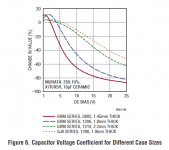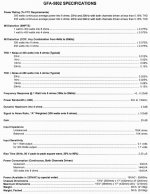I think BSST meant this
Interesting for some applications no doubt, but still Class II ceramic. My enthusiasm for general purpose use is dampened by the range of values vs package size available, too. If it came in X7R type values it would be great.
Murata GJ8 series :
https://www.eetimes.com/murata-low-profile-capacitors-reduce-acoustic-noise/
Patrick
.
https://www.eetimes.com/murata-low-profile-capacitors-reduce-acoustic-noise/
Patrick
.
Attachments
For low distortion, I would look at Polypropylene capacitors. For small sizes maybe the COG ceramic capacitors. Every choice of components has a tradeoff.
This a pretty good page for capacitor distortion info, posted on Jan Didden's website........Cyril Bateman's Capacitor Sound articles:
Cyril Bateman's Capacitor Sound articles | Linear Audio NL
This a pretty good page for capacitor distortion info, posted on Jan Didden's website........Cyril Bateman's Capacitor Sound articles:
Cyril Bateman's Capacitor Sound articles | Linear Audio NL
For the 'extreme' of reducing capacitance change due to voltage, there's the idea of biased capacitors (as seen in some high-end loudspeaker crossovers). Each frequency-determining cap is two capacitors in series of twice the desired value, with the center connection through a high value resistor to + or - power rail or a substantial percentage of the capacitor voltage rating. This puts the capacitance change further up the curve so it doesn't change as much with voltage change. Also, as the capacitors are oppositely charged, the voltage across one goes up while the voltage on the other goes down, tending to cancel the capacitance change.
Using Polypropylene capacitors in loudspeaker crossovers is a simpler solution (but they are large and expensive).
The use of polypropylene is of no benefit at all because loudspeakers have a THD of up to 10%. and more.
That used to be but many contemporary speakers get below 0.1% over a large portion of the working space.
But yes, still (far) below the capacitors in the filter.
Jan
But yes, still (far) below the capacitors in the filter.
Jan
Murata GJ8 series :
https://www.eetimes.com/murata-low-profile-capacitors-reduce-acoustic-noise/
Patrick
.
Thanks, I had seen this article but didn't realize it had a DC bias graph in it. I tend to use Murata because you can find all the characteristics of the parts via the SimSurfing tool.
The use of polypropylene is of no benefit at all because loudspeakers have a THD of up to 10%. and more.
Does that mean that you think that using electrolytic capacitors in the crossover network is OK for the best sound? 🙂.
Cheers,
Bob
Connecting a telephone handset to a $5000 high end amplifier will not improve the sound quality ;-) The currents in a loudspeaker are so large and the capacities so small that there are so many THD that polypropylene is no longer useful. A good electrolytic capacitor with a low ESR is sufficient.
Last edited:
Connecting a telephone handset to a $5000 high end amplifier will not improve the sound quality ;-) The currents in a loudspeaker are so large and the capacities so small that there are so many THD that polypropylene is no longer useful. A good electrolytic capacitor with a low ESR is sufficient.
But wouldn't your own argument apply to the power amplifier? Would that mean that very high quality low-distortion amplifiers make no difference? It seems to me that arguments like this can lead us down a slippery slope 🙂.
Cheers,
Bob
Bob,
I suspect you and many others know about Equivalent Series Resistance understand that alone is enough reason to use film capacitors in most crossovers. Of course some designers will use electrolytic capacitors and allow for ESR contributions.
Film and foil capacitors of course are sometimes strongly affected by vibrations as noted by some who place the crossover outside the loudspeaker enclosure.
Worrying about obsolete as the film is no longer available capacitor types such as polystyrene is at best an academic excercise. So it will no doubt linger in these types of threads almost forever.
With really good transducers I would put Mylar on the list of capacitor types to avoid. Although they are probably the most common film capacitors.
But I cannot argue with someone who has tried an experiment and reports hearing no difference. Proving a negative is an excercise in futility.
I suspect you and many others know about Equivalent Series Resistance understand that alone is enough reason to use film capacitors in most crossovers. Of course some designers will use electrolytic capacitors and allow for ESR contributions.
Film and foil capacitors of course are sometimes strongly affected by vibrations as noted by some who place the crossover outside the loudspeaker enclosure.
Worrying about obsolete as the film is no longer available capacitor types such as polystyrene is at best an academic excercise. So it will no doubt linger in these types of threads almost forever.
With really good transducers I would put Mylar on the list of capacitor types to avoid. Although they are probably the most common film capacitors.
But I cannot argue with someone who has tried an experiment and reports hearing no difference. Proving a negative is an excercise in futility.
But wouldn't your own argument apply to the power amplifier? Would that mean that very high quality low-distortion amplifiers make no difference? It seems to me that arguments like this can lead us down a slippery slope 🙂.
Cheers,
Bob
It's a nice discipline to have a 0.0001% THD in the audio chain. But you should remember that the crux of the matter comes at the end: loudspeakers. They are not that great. Records aren't that great either. The two have up to 100,000 times more distortion than the rest of the chain. But right now we have nothing better.
Yes, we all still have a lot to learn (and maybe never will) about the subjective vs. objective in audio. For example, many people prefer the sound of tube amplifiers, and some sound really good. I've built a tube amplifier as recently as 2012 or so, and it sounded good. Whether that was from some kind of friendly coloration or distortion, who knows? I think that some forms of distortion are more benevolent and some are more malevolent.
The same goes for vinyl. Some love its sound, even though there are many objective reasons why it should not sound good. It is possible that the many ways in which the signal being recorded must be processed to stay within amplitude, velocity and acceleration limits fundamental to the vinyl recording process give it a more mellow sound. I still don't like the noise and pops and clicks, but every once in awhile at a show I hear a very quiet, very good LP and am surprised.
Speaking of that, mastering plays a huge role in the sound of recorded music, be it on CD or SACD. I have SACDs that sound like crap because they were not mastered any differently than the crappy way the corresponding CD was mastered. BTW, "Remastered" is not necessarily better. Sometimes the dynamic range is actually reduced to make the CD sound better in a noisy environment like a car. I have often suspected that SACDs that plainly sound better are that way more because they were mastered differently for a high-end audience than because of the better SACD technical quality.
Cheers,
Bob
The same goes for vinyl. Some love its sound, even though there are many objective reasons why it should not sound good. It is possible that the many ways in which the signal being recorded must be processed to stay within amplitude, velocity and acceleration limits fundamental to the vinyl recording process give it a more mellow sound. I still don't like the noise and pops and clicks, but every once in awhile at a show I hear a very quiet, very good LP and am surprised.
Speaking of that, mastering plays a huge role in the sound of recorded music, be it on CD or SACD. I have SACDs that sound like crap because they were not mastered any differently than the crappy way the corresponding CD was mastered. BTW, "Remastered" is not necessarily better. Sometimes the dynamic range is actually reduced to make the CD sound better in a noisy environment like a car. I have often suspected that SACDs that plainly sound better are that way more because they were mastered differently for a high-end audience than because of the better SACD technical quality.
Cheers,
Bob
Yeah, the story of making the Steely Dan album AJA is pretty nice background to some of the extreme stuff that can go into tweaking the sound for a recording.
....."Make it perfect, then make is less perfect" (more friendly).
I bought a Musical Fidelity amplifier in the mid 1990s & it did sound musical, but it also sounded muddy or murky. I sent it back, since I could not live with that sound. Then I bought an Adcom GFA5802 & GFP750, which sounds much more clear than the Musical Fidelity amplifier. The Adcom amplifier works OK, but it could also double as a room heater.
I listen to a lot of different types of Music: Blues, Jazz, Classical, Folk, Rock (a lot of variation in Rock). I tended to like the cleaner recordings where one can hear all the instruments separately & clearly.
I think the best stereo, I remember ever hearing was set of huge flat panel speakers driven by an AR tube amplifier, playing a vinyl recording. I think that was at 1977 or 1978 CES show in Las Vegas. Some of the old direct to disc (vinyl) recordings from 1977-1979 sounded pretty good.
Video, story of the making the Steely Dan album AJA: Steely Dan Aja - YouTube
....."Make it perfect, then make is less perfect" (more friendly).
I bought a Musical Fidelity amplifier in the mid 1990s & it did sound musical, but it also sounded muddy or murky. I sent it back, since I could not live with that sound. Then I bought an Adcom GFA5802 & GFP750, which sounds much more clear than the Musical Fidelity amplifier. The Adcom amplifier works OK, but it could also double as a room heater.
I listen to a lot of different types of Music: Blues, Jazz, Classical, Folk, Rock (a lot of variation in Rock). I tended to like the cleaner recordings where one can hear all the instruments separately & clearly.
I think the best stereo, I remember ever hearing was set of huge flat panel speakers driven by an AR tube amplifier, playing a vinyl recording. I think that was at 1977 or 1978 CES show in Las Vegas. Some of the old direct to disc (vinyl) recordings from 1977-1979 sounded pretty good.
Video, story of the making the Steely Dan album AJA: Steely Dan Aja - YouTube
Attachments
I didn't mean to derail the thread, the biased capacitor thing may be diminishing returns or be over-the-top in many applications, but when going for hard-to-measure distortion levels in oscillators like like in this thread it seems like just the thing.
It feeds a part of the signal to the gate of the level control FET. In this way, distortion can be set to minimum.
It probably also influences the output level.
Jan
It probably also influences the output level.
Jan
- Home
- Design & Build
- Equipment & Tools
- Low-distortion Audio-range Oscillator



